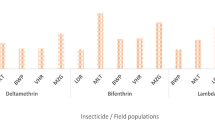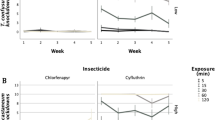Abstract
INSECT hormones, and compounds which mimic their effects, have potential as insect control agents. Substances with juvenile hormone activity have considerable promise in this respect, and it has been suggested that insect strains resistant to such compounds would be unlikely to evolve1,2. The present study shows that a strain of Tribolium castaneum resistant to many conventional insecticides is also resistant to juvenile hormone.
This is a preview of subscription content, access via your institution
Access options
Subscribe to this journal
Receive 51 print issues and online access
$199.00 per year
only $3.90 per issue
Buy this article
- Purchase on SpringerLink
- Instant access to full article PDF
Prices may be subject to local taxes which are calculated during checkout
Similar content being viewed by others
References
Williams, C. M., Nature, 178, 212 (1956).
Williams, C. M., Scientific Amer., 217, 13 (1967).
Champ, B. R., and Campbell-Brown, M. J., J. Stored Prod. Res., 6, 111 (1970).
Dyte, C. E., Rowlands, D. G., Daly, J. A., and Blackman, D. G., Pest Infest. Res., 1969, 41 (1970).
Dyte, C. E., Trop. Stored Prod. Inf., 20, 13 (1970).
Author information
Authors and Affiliations
Rights and permissions
About this article
Cite this article
DYTE, C. Resistance to Synthetic Juvenile Hormone in a Strain of the Flour Beetle, Tribolium castaneum. Nature 238, 48–49 (1972). https://doi.org/10.1038/238048a0
Received:
Issue date:
DOI: https://doi.org/10.1038/238048a0
This article is cited by
-
10.1007/BF00302867
CrossRef Listing of Deleted DOIs (2011)
-
Possibilities of using insectistatics and pheromones in pest control
Die Naturwissenschaften (1975)



